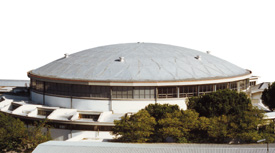Benvenuto
by Stefano Bianco
Mario Calvetti of the University of Florence has been named the new director of Frascati National Laboratories by Italy's Istituto Nazionale di Fisica Nucleare (INFN), marking a return to the origins of his scientific career.
 The DAΦNE building. |
"Frascati represents my schooling in experimental physics," Calvetti says. "I came here in 1971 as an undergraduate. My wife and I lived here as newlyweds with our firstborn boy, Francesco. Professionally, I had the opportunity of participating in all phases of the experiment that led to the observation of the J/ψ at ADONE, following the particle's initial discovery in the United States. This appointment has the feeling of a homecoming."
With an initial three-year appointment, Calvetti succeeds Sergio Bertolucci, Frascati's director since 2002. Frascati is the largest of the INFN laboratories, employing some 370 researchers, technologists, technicians and administrative personnel, with an additional 400 guest and visiting scientists.
"This is a very active lab, with varied expertise," Calvetti says. "Frascati is a major asset of the Italian physics community. Our lab also offers many opportunities for scientists in other disciplines, such as medical physics, materials science, and synchrotron radiation physics."
Home of the first e+-e- collider ever built (the ADA storage ring began operation in 1961), Frascati currently houses the DAΦNE Φ-factory. Frascati groups collaborate on experiments in particle, nuclear and astroparticle physics at major laboratories around the world. Strong detector R&D programs, accelerator science studies, and synchrotron radiation facilities complete the research program.
 Professor Mario Calvetti, Director |
Under Calvetti's leadership, Frascati will seek to combine its ongoing physics program with a strategy for the future. The DAΦNE program is scheduled to continue into 2008 with the KLOE, FINUDA, DEAR, and SIDDHARTA experiments. Frascati groups are heavily committed to Large Hadron Collider experiments at CERN, both in detector construction and data analysis. "We build experiments to do data analysis, and take physics results," Calvetti says. "LHC computing represents a great challenge."
Programs already under development for the post-2008 era include the Free Electron Laser, a proton synchrotron for cancer treatment, and accelerator science studies on the Linear Collider. Calvetti brings a multidisciplinary and collaborative vision for the future, including options for a post-DAΦNE machine. "The natural option is a luminosity upgrade to study kaon physics," he says. "It only makes sense if complementary programs will be initiated abroad, such as at CERN or Fermilab."
"The other option is a tau-charm factory, a project for which skills exist in Frascati; however, this would require a change in the laboratory infrastructure. Internationalization is essential for a tau-charm factory, and the recommendation for building it must come from the international community. By 2012, we shall know from LHC experiments whether supersymmetry does exist. If it does, low-energy machines such as a tau-charm factory will be important for providing necessary information to select among [supersymmetry] models." Calvetti's scientific achievements range from the observation of the J/ψ at Frascati, to the discovery of the W and Z bosons at the UA1 experiment at CERN, and to the discovery of direct CP violation in the K meson system at CERN's NA31 and NA48 experiments. Calvetti has served as president of CSN1 (the funding board of INFN for high-energy physics) from 1997 to 2001, and as president of the LHC Committee from 2001 to 2004.
 Photos: Courtesy of INFN Servizio Informazione Scientifica-Fotoaudiovideo Photos: Courtesy of INFN Servizio Informazione Scientifica-Fotoaudiovideo |
Click here to download the pdf version of this article.






